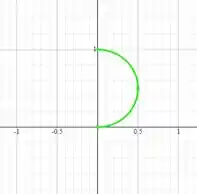Usando coordenadas polares, calcular:
d)
Passo 1
Temos que:
A representação da região de integração é dada:

Assim:
Como:
; ;
Temos:
Desse modo, temos que:
Passo 2
As coordenadas polares se dão da seguinte forma:
; ;
Então, substituindo na equação dada, temos:
Passo 3
Integrando para :
Aplicando os limites:
Passo 4
Integrando para :
Aplicando os limites: